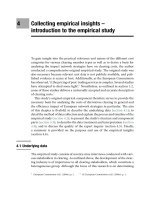Understanding cryptocurrencies the money of the future
Bạn đang xem bản rút gọn của tài liệu. Xem và tải ngay bản đầy đủ của tài liệu tại đây (865.57 KB, 83 trang )
Understanding Cryptocurrencies
Understanding Cryptocurrencies
The Money of the Future
Arvind Matharu
Understanding Cryptocurrencies: The Money of the Future
Copyright © Business Expert Press, LLC, 2019.
All rights reserved. No part of this publication may be reproduced, stored in a retrieval system, or
transmitted in any form or by any means—electronic, mechanical, photocopy, recording, or any
other except for brief quotations, not to exceed 400 words, without the prior permission of the
publisher.
First published in 2019 by
Business Expert Press, LLC
222 East 46th Street, New Y ork, NY 10017
www.businessexpertpress.com
ISBN-13: 978-1-94858-065-6 (paperback)
ISBN-13: 978-1-94858-066-3 (e-book)
Business Expert Press Finance and Financial Management Collection
Collection ISSN: 2331-0049 (print)
Collection ISSN: 2331-0057 (electronic)
Cover and interior design by Exeter Premedia Services Private Ltd., Chennai, India
First edition: 2019
10 9 8 7 6 5 4 3 2 1
Printed in the United States of America.
Abstract
The book intends to provide a high level overview of cryptocurrencies to a
new enthusiast by using layman language and limiting many of the technical
aspects, providing a very condensed version of this vast development of
digital currencies.
Blockchain is the new revolution after the Internet that is going to change
how we do business today. Cryptocurrencies are the money of the future.
These two statements are a positive affirmation from many corners around
the world. The author provides a balance of introduction and depth regarding
blockchain, hot cryptocurrencies, and their comparisons.
Bitcoin, being the pioneer, is discussed in greater detail. The reader will
gain the basic idea of bitcoin mining, trading, and investing. With special
interest in the various usages of blockchain and interest on traditional
banking systems are also discussed.
Keywords
bitcoin; blockchain; borderless currency; cryptography; decentralized
technology; digital ledger; ethererum; impact on traditional banking system;
increasing acceptance of digital currencies by online businesses; leading
cryptocurrencies and their comparison; money of the future; peer-to-peer
participation; proof-of-work
Contents
Chapter 1Introduction to Cryptocurrency
Chapter 2Blockchain Is the New Revolution After the Internet
Chapter 3Hot Cryptocurrencies Around the World
Chapter 4What Makes Bitcoin So Popular?
Chapter 5Comparison of Various Cryptocurrencies
Chapter 6How to Get Started on Bitcoin
Chapter 7Bitcoin Mining
Chapter 8Learn Bitcoin Trading and Investing
Chapter 9Future of Digital Money
Chapter 10How a Blockchain Is Expected to Change Various Record Keepings
Chapter 11Impact on the Traditional Banking System
Additional Readings
About the Author
Index
CHAPTER 1
Introduction to Cryptocurrency
What Is Cryptocurrency?
Cryptocurrency is the money of the future. In the current digital era, digital
money was already overdue, which makes the arrival of cryptocurrency
during the past 9 years as no surprise. Cryptocurrency is a digital or virtual
currency that is still in its embryonic stage and has been gaining lots of
attention worldwide. It has not replaced the government-issued money yet
due to various factors inherent to it. However, the technological advances are
filling the gaps and overcoming the current obstacles slowly and steadily.
Remember when the plastic money, that is, credit cards were introduced?
Everyone would have thought that time that how a plastic card may be used
instead of paper currency. And today, it is unimaginable for a common
person to be without credit cards. The initial resistance was overcome by
taking care of challenges related to plastic money. On that note, the day is
not far when cryptocurrency may remove the need of banks.
The reasons for the attention gained by cryptocurrencies during the past
10 years are multifold. First, it does not exist in a tangible or physical form. It
is not a government-issued currency printable on paper. Cryptography is
used to ensure its attributes to be used as a currency by which a
cryptocurrency can be used as a medium of exchange and perform monetary
transactions, in the same way as the printable bills can be used.
Cryptography is the science by which intelligible data or information can be
scrambled or concealed by using encryption techniques. Encryption is done
from the sender side to make the intelligible data into an unintelligible one.
Whereas, on the receiver side, the decryption takes place to bring the
encrypted data back into an intelligible form again. The processes of
encryption and decryption take place via an algorithm. An algorithm stands
for a set of instructions in the world of computing. These instructions in a
computer programming language perform a specific task.
Cryptocompare.com depicts the process of cryptography in the following
diagram:
Cryptocurrency derives its name from two words, namely, cryptography
and currency; a digital currency controlled by cryptography. A cryptocurrency
has no inherent value; however, its value comes from the people’s belief in it.
Definitions and Attributes of Cryptocurrency
The Merriam-Webster dictionary defines cryptocurrency as follows:
any form of currency that only exists digitally, that usually has no
central issuing or regulating authority but instead uses a
decentralized system to record transactions and manage the issuance
of new units, and that relies on cryptography to prevent counterfeiting
and fraudulent transactions.
The definition from online Oxford dictionary is as follows:
A digital currency in which encryption techniques are used to regulate
the generation of units of currency and verify the transfer of funds,
operating independently of a central bank.
From these two definitions, the following conclusions can be drawn:
1. Cryptography manages the cryptocurrency by using encryption and
decryption techniques.
2. Cryptocurrency is a digital asset that can be used in place of a printable
currency toward monetary transactions.
3. There is no central issuing or regulating authority.
4. A decentralized method is used to verify, record, and monitor all the
transactions.
5. The decentralized system manages the issuance of new units; those are
generally limited in number by the governing algorithm.
Considering cryptocurrency has no central or regulating authority; its
value is defined by consensus from people believing in it. It is a borderless
currency with which international payments can be made cheaper than
conventional currencies. A conventional currency such as a U.S. dollar is
governed by a central bank that defines its value represented by printable
bills, coins, drafts, cheques, or other similar banking instruments. The value
of cryptocurrency comes from an encrypted code that is difficult to
reproduce, making it scarce and limiting its numbers, unless the creator of
cryptocurrency decides to change the underlying algorithm to create more
units. Being a bank-free or border-free currency, cryptocurrency offers an
alternative to conventional currencies.
The basic unit of a cryptocurrency is called a coin that is an encrypted
code consisting of a string of characters. A coin is merely an entry in a
database available publicly via a blockchain that can be called as a distributed
ledger.
A blockchain validates the coins of cryptocurrency. A blockchain is
certainly a revolution that is here how we are going to see the world in the
coming decades. The blockchain is already in the process of making its place
as something much bigger than the Internet itself.
What Are Its Origins?
Bitcoin is generally accepted as the first cryptocurrency that came in the
form of open-source code in 2009. As the source code is openly available,
there are thousands of variants of the original bitcoin available today. Such
variants are also called alternative coins (altcoins) that stand for alternative
digital currencies.
In October 2008, Satoshi Nakamoto published a paper titled Bitcoin: A
Peer-to-Peer Electronic Cash System. The identity of Satoshi Nakamoto is
still unknown, whether Satoshi is an individual or a group of individuals. In
this white paper, Satoshi Nakamoto created and developed bitcoin’s original
reference implementation. Using the blockchain database, Satoshi released
the very first bitcoins in January 2009. Satoshi mined the genesis block of
bitcoin, also known as block 0 (zero). Mining is a process by which
individuals verify and record the transactions. This set of transactions is
called a block, which gets added on top of the past blocks. Altogether, this
chain of blocks (of transactions) is known as a blockchain. Miners doing
mining are rewarded for their efforts. It is interesting to know that the
genesis block had a reward of 50 bitcoins. The genesis block has a timestamp
of 18:15:05 GMT on January 3, 2009.
As words such as cryptocurrency, blockchain, bitcoin, and mining will be
commonly used throughout this book, these topics will be dealt in more
detail in the upcoming chapters.
Why Is It Important to Know About
Cryptocurrency?
Cryptocurrencies have seen a significant growth in 2017. There have been
wild swings in their value, making these very risky and volatile, due to which
these get labeled as a bubble as well. It is very unpredictable when the price
continues to rise, and then falls suddenly, only to come back with a newer
peak, and so on. People look at cryptocurrencies with various perspectives.
Some look at it to perform actual monetary transactions. Some look at it as
miners to get rewarded. Some look at it as an investment where retail and
institutional investors continue to increase with time. Lot new interest from
various other perspectives make cryptocurrency a very interesting digital
asset.
What Is the Legal Status of Cryptocurrencies?
The legal status of cryptocurrencies is under radar by most of the countries.
The stand varies from country to country. Though their usage may not be
illegal and can be used as a medium of exchange in some countries, some
countries have taken a hard step to ban or restrict. Countries such as Bolivia,
Ecuador, India, Nigeria have declared public statements declaring such
restrictions.
Bitcoin being the most popular one, the U.S. Treasury classified it as a
convertible virtual currency, and taxed it as a property. Governments
worldwide are taking steps to include the transactions using cryptocurrencies
into their taxation system.
Is This Not Used for Anonymous Transactions
for Illegal Purposes?
The dark side of cryptocurrencies is related to the common notion that these
are used for illegal activities, especially on the Dark Web. This leads to
continuous rise in the price of the coins. It is unfortunate that more than a
quarter of bitcoin usage is linked with criminal activities due to its
anonymity. It is important to understand that, just because cryptocurrencies
are used by criminals, it should not lead to the conclusion of making
cryptocurrency illegal. With the technological advances, and appropriate
legislations and controls, it can be better used as a valid and reliable form of
currency, making it the future of the money.
CHAPTER 2
Blockchain Is the New
Revolution After the Internet
What Is a Blockchain?
The blockchain is the brainchild of Satoshi Nakamoto as referenced in
Chapter 1. Satoshi used two separate words, block and chain. With time, the
two words have combined into a single word blockchain. Originally,
blockchain was devised for bitcoin (cryptocurrency), but it has evolved much
bigger since then. A blockchain can be viewed as a publicly available digital
ledger that contains a record of the transactions. This kind of database is
accessible to anyone, and there is no centralized version of it. In other words,
a blockchain is a decentralized technology. It is important to understand that
the blockchain technology is not necessarily for financial transactions only,
and it can be used wherever any uniqueness of records is required.
A blockchain is presented by Blockgeeks.com in the diagram shown on
page 8.
The users of the network participate in the blockchain. This user-to-user
(peer-to-peer) participation makes the blockchain centralized. This kind of
recordkeeping can be extended to any business domain. The full potential of
application of the blockchain technology is still under investigation. The
most attractive part of the blockchain is removal of the intermediary party
between two users. Currently, finances and identity management are on the
top of the applications of a blockchain.
The white paper by Satoshi refers to blockchain as follows:
…system based on cryptographic proof instead of trust, allowing any
two willing parties to transact directly with each other without the
need for a trusted third party…
Currently, most of the systems on the Internet require a third party that
blockchain tends to eliminate altogether. This elimination of third-party
intermediaries is certainly a threat to the conventional (and expensive)
methods.
Accordingly, a blockchain can be considered to have the following
attributes:
1. Consider this as a digital ledger available publicly.
2. Records in this shared ledger use encryption and decryption.
3. Timestamped creation, validation, verification, and monitoring of the
transactions in a decentralized manner.
It should be noted that a blockchain does not have to exist publicly. In
that case, the nodes exist in a private network with access to the distributed
ledger. A blockchain is a continuously growing list of records, called blocks,
linked using cryptography. A block contains a group or batch of valid
transactions. A block in the blockchain has the cryptographic hash of the
previous block in the blockchain. A cryptographic hash is equivalent to a
digital fingerprint. This linking of the adjacent blocks forming the chain
resists the modification of the data contained within the blockchain. The
authentication of the records takes place with the mass collaboration by the
users. This makes the blockchain a secure database where the records
become almost unalterable. Conventional centralized databases have their
own challenges related to data integrity and security at very high costs to the
businesses that get eliminated with the use of the blockchain technology.
The data integrity of the records is an iterative process tracing back to the
genesis block. Consider the genesis block as the very first block of the
blockchain, also called as block 0. As mentioned earlier, cryptocurrencies are
based on the open-source code that anyone may update to create newer
digital currencies. A genesis block is generally hardcoded in the software,
that is, already present in the base software. This is the only time, where the
genesis block is not linked with any previous block via cryptographic hashes.
A blockchain can be visualized as a vertical stack that is ever growing with
new blocks, where every new block is back-linked with the previous one. The
first block is base of this vertical stack. The latest block is called the top
block. The distance between two blocks is called height.
Structure of a Blockchain
A blockchain is a chain of blocks, where a block contains a batch of
transactions. A block also contains a header. The transactions are organized
in a hash tree along with the hash of the root in the header. A hash tree or
Merkle tree in cryptography is a hash-based data structure that is a
generalization of the hash list. A Merkle tree is a tree structure in which each
leaf node is a hash of a block of data, and each non-leaf node is a hash of its
children. In a binary tree, a node is a leaf node if both the left and right child
nodes of it are null.
Researchers Wei Cai and Victor Leung of the University of British
Columbia present the blockchain structure in a simple diagram as follows:
Merkle trees are efficient due to hashes, where hashes can be viewed as
ways of encoding files that are much smaller than the actual file itself. In a
Merkle tree, each node has up to two children, technically known as
branching factor of two. These trees facilitate efficient and secure verification
of very large data structures.
How Is a Blockchain Linked to
Cryptocurrencies?
A blockchain is to cryptocurrencies, what the Internet is to an e-mail. An email can be sent using the Internet, though the Internet can be used for
many more other purposes as well. Similarly, cryptocurrencies are built on
the blockchain technology, whereas a blockchain can perform things much
more than handling cryptocurrencies. The details of such usages are covered
in the chapter where use cases are elaborated.
All cryptocurrencies are blockchains, but all blockchains are not
cryptocurrencies. Both blockchain and cryptocurrency go hand in hand. A
blockchain can be extended to anything of value, and not currency only.
Blockchain is a technology, whereas cryptocurrency is an asset. Bitcoin being
the first application of blockchain, the two terms bitcoin and blockchain got
used inadvertently for quite some time. However, blockchain has evolved
much bigger than just supporting cryptocurrencies only.
A cryptocurrency is a digital token used for a monetary transaction
between two individuals. A number of nodes validate the transaction without
involving any expensive third-party intermediaries. The nodes have their
individual copy of the distributed ledger where various users verify whether
the token is double spent or not. Also, the balance is published after the
users have verified the transaction. The updated ledger gets published every
10 minutes for bitcoin. This update includes the consensus-based batch of
transactions in the form of a block on top of the current tree. The users
worldwide must agree to the legitimacy of the transaction. Once a block gets
added to the blockchain, the balances get updated permanently.
The blockchain relies on the computer processing power of the network.
The users within this network update the distributed ledger and secure the
blockchain. That is why, it is important to have a variety of users worldwide.
Generally speaking, a healthy blockchain exists if one group of users or an
organization does not own more than 51 percent of the computers on the
network. Ownership more than this potentially may lead to stop
transactions, hence making the blockchain ineffective.
Technological Overview of a Blockchain
A blockchain is a chain of back-linked blocks, with each block containing a
batch of transactions, where the number of transactions are set by the
underlying protocol. A network of participating computers called nodes
continue to add and store blocks in this blockchain. These nodes verify the
transactions before adding these to the block. The nodes also solve the
underlying complex mathematical problem. After these two activities, the
block gets added to the blockchain with reference to the previous block.
Encryption and decryption are used for the security of the data. A
mathematical formula is used to hide data using encryption, whereas
decryption is used to bring the hidden data back into its original form. A
blockchain uses cryptographic hashing to achieve this. The mathematical
formula used to encrypt the data related to the transaction along with
metadata produces the output called hash. This hash can be viewed as
compact information regarding data. With the help of set of keys, the same
hash gets produced.
The public key and private key play a significant role between the two
users (of a transaction). The public key, as the name suggests, is available
publicly, but the private key is not. The sending party uses the private key to
send the data (transaction) in an encrypted form. The nodes use the public
key to decrypt the sent data to ensure that there is no double spending.
Double spending gains more relevance in digital currencies, as digital
information can be reproduced relatively easily, which may be used twice or
multiple times. To avoid this problem, the cryptographic protocol called
proof-of-work (PoW) is used. This ensures that the digital currency is not
used more than once by the user. A blockchain uses the SHA256 PoW
function that makes the verification process hard to compute, but easy to
verify, to avoid the double-spending problem. On that note, there are many
PoW systems.
A cryptographic hash is a signature of the digital data, where the SHA256
function produces a 256-bit, that is, 32-byte signature of the digital data. This
generated signature of a fixed length is almost unique, which cannot be
decrypted back into the original data. Regardless of small or big data, the
SHA256-produced signature has a fixed length always. Based on the theory of
probability, there are extremely low chances to have same signature or hash
due to 2^128 possible combinations.
Technically speaking, a hash pointer is used to back-link to the previous
block in a blockchain. The hash pointer is a combination of the address of the
previous block and the hash of the data within the previous block. This
makes the blockchain very secure, as it keeps on building on previous blocks.
A block header contains the block version number, current timestamp,
computational problem, hash of the previous block, nonce, and hash of the
Merkle root. A nonce is an integer between 0 and 4,294,967,296.
Microsoft has presented the block structure as follows:
Why Are Users Validating the Transactions?
The users on the network gets rewarded for their collaborative efforts to
validate the transactions. The activity of looking for a new potential block to
be added to the blockchain is called mining. The users performing the mining
process are called miners. The process of mining involves compiling new
recent transactions, in the form of a block and solve a comparatively difficult
mathematical problem. The miners verify that the new transactions are
legitimate. When a transaction gets broadcasted on the network, various
miners around the world get on the task of mining. In a way, a competition
starts to verify the new transactions to be part of a potential new block and
solution to the computational problem. However, a winner is who is able to
provide a PoW first, which the block gets added to the blockchain. The
winner miner gets rewarded for this effort of mining in the form of
cryptocurrency coins. The difficulty of calculating hashes increases with
every iteration. This makes the digital currency increasingly scarce similar to
printable currency. The underlying algorithm of the cryptocurrency poses a
limit on the number of coins, for example, bitcoin can have a maximum of 21
million bitcoins as per the current algorithm.
Why Is Blockchain Gaining So Much
Importance?
Many blockchain projects are underway worldwide in what is called Web 3.0.
Web 1.0 was the name given to the very first form of World Wide Web. Web
2.0 came up with global sharing of information and social media. Web 3.0
has the decentralization of information at its heart. This is also called
human-centered Internet because of the fact that the information is back in
the hands of its rightful owners. With decentralization, middle parties are
eliminated; those may have monopolized the related business domain with
their own selfish motives. Overall, the end user has full control over their
data and its security, and not a third party, including government.
Considering the aforementioned benefits of Web 3.0, many applications
have started emerging during the past couple of years that are taking away
the monopoly of existing widespread applications from big corporations.
Brave, Experty, Storj, and Status are some of the examples in Web 3.0
serving the same purpose as Web 2.0 apps browser, video or audio calls,
storage media, and messaging perform.
What Are the Other Uses of a Blockchain?
The blockchain technology is much bigger than supporting cryptocurrencies
only. As mentioned earlier, a public blockchain is a digital register of records
available in a secure and transparent manner, in a decentralized environment
without needing any expensive third-party intermediaries. A blockchain is
expected to have a great use in a number of fields such as identity
management, supply chain management, accounting, voting, stocks, smart
contracts. These usages are also referred as use cases. This topic of other
uses of a blockchain is dealt with in a greater detail in Chapter 10.
What Are the Hardware or Software
Requirements?
The system requirements of a blockchain in terms of hardware and software
vary drastically based on the perspective. The perspectives may include those
of an end-user, investor, developer developing the blockchain, and company
investing in the blockchain project internally or externally. For an end-user
or investor, there is no typical requirement, and a normal laptop in current
use can be used. Developers need access to the relevant programming
language for development. The computation power increases dramatically for
the nodes performing mining to produce the PoW. This is required as the
increasingly difficult level of computational problem must be solved before
the PoW-supported block can be added to the blockchain.
Why Do I Really Need to Know About It?
In the current digital era in the making of Web 3.0, where a blockchain or
decentralization is focused on bringing control from the big corporations to
the end-user, it is certainly of interest to anyone who would like to see
reduced costs of operations while being in a safe and secured environment,
where the transactions take place in an efficient and quicker manner.
CHAPTER 3
Hot Cryptocurrencies Around
the World
Is Bitcoin the Only Cryptocurrency?
Bitcoin is not the only cryptocurrency. Bitcoins are generated from the opensource code that anyone can modify. The bitcoin inspired many other
alternative digital currencies (altcoins) to come in existence, which happened
by changing the underlying algorithm. The framework offered by bitcoin still
remains at the core for the newer altcoins. These altcoins are similar to
bitcoins. Every altcoin has its own blockchain and consensus rules.
Altcoins differ from bitcoins in many ways. Some altcoins offer better
privacy, and others may offer lesser privacy. Some offer different proof-ofwork functions, while others may not offer any at all. There are many
altcoins those have just updated some parameters in the original open freesource code and those may not be that important. Most of the available
altcoins today can be called bitcoin clones, where an insignificant parameter
such as transactions speed, distribution method, or hashing algorithm are
updated, adding not much value to this new altcoin.
In fact, increasing the number of overall coins in an altcoin is similar to
effects produced by increasing the printable currency, that is, it becomes
readily available, hence becomes lesser in value. The consensus rules and the
computational problems to be solved further decide the value of an altcoin.
Some people may think that they have missed the wave of a bitcoin, and start
investing in some obscure altcoin, that is very risky.
What Are Other Cryptocurrencies?
Currently, there are more than 1,000 altcoins in place. Anyone can create a
new altcoin anytime. A bitcoin is the most known digital currency with
maximum market capitalization and the largest blockchain. Next to bitcoin
are Ethereum, Ripple, Bitcoin Cash, Litecoin, and many more.
It must be noted that the digital currencies have captured market worth
more than 250 billion U.S. dollars. This has potential to disrupt the
conventional financial world where the government-issued currency is
dominant. Decentralization would also mean that the control will not be in
the hands of government or big corporations, instead the control will be in
the hands of a common person. For survival of big corporations, sooner and
later, they have to adopt to the blockchain framework. Even if some
countries have banned cryptocurrencies, still its mass adoption in
technological giants are making them stronger.
Bitcoin certainly has the advantage of being the first cryptocurrency that
is also the most known and widely accepted one. Bitcoin alone has captured
market worth more than 100 billion U.S. dollars. The immediate next one is
Ethereum with market capitalization of more than 45 billion U.S. dollars.
Also, bitcoin has the most value compared to the altcoins. The year 2017
really captured the attention worldwide where the bitcoin price soared super
high. For bitcoin value, compare its value of 800 U.S. dollars in January 2017
with approximately 18,000 U.S. dollars in December 2017. That is where
bitcoin captured so much attention, and everyone wanted to know about this
biggest technological breakthrough after the Internet. No other commodity,
including gold or stock, has soared so high in value in so less duration.
The list of other cryptocurrencies called altcoins apart from bitcoin
continues to change at a rapid speed based on various factors, including
market capitalization. Regardless, Ethereum, Ripple, Litecoin, Dash, NEM
continue to be in the top 10 of the list.
Why So Many Cryptocurrencies?
After bitcoin in 2009, Namecoin was the first altcoin produced in 2011. It is
interesting to note that, even if more cryptocurrencies may seem not adding
value to the world of cryptocurrencies, still these further solidify the idea of
decentralization. This allows developers to experiment with more and more
features or functions. The bitcoin community may decide to pick up anything
useful from those new experiments, making bitcoin innovating, stronger, and
secure.
Many altcoins came into existence due to the availability of free opensource code of bitcoin. These altcoins appeared by presenting themselves as
better variants of bitcoin that may not be the case in reality. Various
cryptocurrencies have declared their own focus as well. Various identified
goals are such as smart economy based on digital assets, smart contracts,
cheaper international handling of funds, decentralization application
platform. All such goals lead to the creation or existence of currently
available cryptocurrencies. General market opinion is that such big market
capitalization may be based on speculation only, and not necessarily due to
the technology factor.
Each cryptocurrency has its own motive. Due to the huge success and
presence of bitcoins, other people started their own digital currencies as to
become rich quickly. They may have presented almost similar coins, and kept
many coins with them in the beginning, with a hope that their coin would get
popular and they will hit the jackpot too. Not to forget, even a fraction of
market capitalization of bitcoin has the potential of making people
millionaires in the quickest way possible.
On the other hand, the altcoin may be really good one, in which the
developers are experimenting with new ideas, functions, or parameters. They
have far better motives than the ones mentioned in the previous paragraph.
Again, there is a hope that those altcoins will get popular one day, and the
creators reap the benefit out of those, even if a fraction of those by bitcoin.
Ethereum stands apart from other altcoins, as it focused on fixing the
problems with bitcoin. The bitcoin blockchain has already gone so far, that
one cannot go back to fix those. On that note, Ethereum has presented smart
contracts, and offers Ethereum virtual machines (EVMs). This way, it is
much more than an altcoin. Stated correctly, Ethereum offers a decentralized
platform to run smart contracts. These offer applications without the need of
a complex business logic, downtime, fraud, or third-party interference.
The digital currencies literally exploded in 2017. Also came the concept of
initial coin offerings (ICOs). The start-up companies offering new
cryptocurrencies raise funds using the ICOs. The venture capitalists have
their rigorous process of fund raising that gets bypassed by the ICOs. In
short, it is viewed as an unregulated means by the startup venturing into new
cryptocurrencies.
Is This a Scam?
Currently, bitcoin investment is very volatile. On that note, investment in the
altcoins is even more volatile, making those riskier alternatives. Similar to
stocks, big players may invest heavily in some new altcoin, giving an
impression that its value will increase more in the coming time. This attracts
the people who may think that they missed the bitcoin boat. When this hype
works for an altcoin, it brings in money from lots of investors. One fine day,
the scammer altcoin disappears after looting this collected money. This
makes very important to avoid any such hype and do due diligence on your
own. As they say, it is not wise to invest more than what one may afford to
lose.
There is a huge rise in new cryptocurrencies after the huge success of
bitcoin and other altcoins. With the digital currencies, cryptocurrency
exchanges also started rising. Their selling factor is security and transaction
fees. Unfortunately, there are not many such exchanges those can be trusted.
Many claiming to be solid exchanges disappeared overnight taking the user
coins with them. Imagine a bank offering lucrative products to attract a huge
number of customers who deposit their assets there. And when millions or
billions of funds get deposited in the bank, the bank disappears overnight!
And there goes all the deposits by the users who trusted that bank.
Unfortunately, some users lost their life savings as well.
Is This a Bubble About to Burst Anytime?
Many analysts worldwide have predicted bitcoin as a bubble and extended
that prediction to altcoins as well. This means a prediction of their collapse
in the near future. As many as eight Nobel laureates have mentioned bitcoin
and altcoins as economic bubbles. A professor even went on to say these as
mother of all bubbles.
Nobel laureate Robert Shiller defines a bubble as:
a situation in which news of price increases spurs investor
enthusiasm, which spreads by psychological contagion from person to
person, in the process amplifying stories that might justify the price
increases, and bringing in a larger and larger class of investors who,
despite doubts about the real value of an investment, are drawn to it
partly by envy of others’ successes and partly through a gamblers’
excitement.
Many experts have criticized cryptocurrencies repeatedly. These have been
compared with Ponzi schemes where one gains returns for a short period of
time, and the actual owners are benefitted based on the trust and
investments by the users. American investor Warren Buffett continues to
repeat his stand against bitcoin by calling them non-productive assets.
Regardless, market has seen a great rise in the price of bitcoin and altcoins during 2017, and it has been continuously increasing, though with
unpredictable slumps in between. People tend to compare the blockchain
with dot-com bubble. During the dot-com period, many people made
enormous money, while many more lost huge amounts. Still, it led to a
technological evolution on which we stand today. Considering this argument,
even if time proves blockchain as a bubble that collapses, still, one must not
forget about the revolution it has created in terms of the idea of
decentralization and ownership coming back into the hands of end users.
The rapid increase in the number of altcoins and their arbitrarily
fluctuating price is a big risk. A user may not understand how a blockchain or
altcoins work and may invest in these, which are strongly not advisable,
considering the digital currencies are yet to mature.
CHAPTER 4
What Makes Bitcoin So Popular?
What Is a Decentralized System?
Decentralization eliminates the third-party intermediaries and connects two
users directly. That is why a decentralized system is also known as user-touser or peer-to-peer system. Currently, Internet is centralized. The two terms
centralization and decentralization are antonyms of each other in terms of a
controlling authority. In a decentralized system, no single authority exists to
control, and there are multiple points to perform the work as per the
prescribed protocol regarding verification, solving of the computation
problems, and consensus method.
Facebook and Google are examples of centralized platforms, whereas
BitTorrent and Napster offer peer-to-peer file sharing on decentralized
platforms. This way, the data is not in the hands of a single party and makes
it much more secure comparatively. Synereo has emerged as a new platform
for decentralized social networking in comparison to Facebook. The users in
this platform can interact with each other directly, without going through a
central server. In addition, the data gets encrypted, increasing the security of
the transferred data. Even the creators of the platform cannot access this
data. Users performing the verification of data get incentive for performing
their tasks for the applications in the decentralized platform.
BitTorrent is a good example to understand a decentralized platform. The
data does not pass through a single point and passes through multiple points
those are part of the peer-to-peer (P2P) network. In BitTorrent, when a user
downloads a torrent file, two numbers get listed for the best file download,









